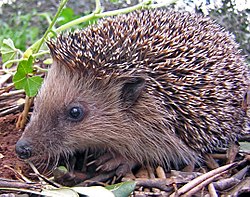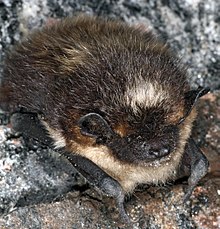Hibernation

As hibernation or Hibernation is called a protracted rest, in particular homoiotherme animals - some mammals and few birds while reducing their - body temperature falls during the cold season. Winter sleepers lower their body temperature to a lower level in autumn, at the same time the respiratory and pulse rates as well as all other metabolic activities slow down . Since the animal does not consume any food during hibernation, the energy for all metabolic activity of the hibernation comes from the fat deposits eaten during the summer.
Individual mammals such as the dormouse , the dormouse , the brown-breasted hedgehog , the marmot or some bats hibernate for a long time with a few short interruptions; If the normal core body temperature remains unchanged during the resting phase, it is called hibernation instead . What all winter sleepers have in common is that they quickly warm up to normal temperature in the event of external disturbances. This is controlled by the release of hormones from the pituitary gland . When heated, they consume significant amounts of fat, which is why the animals can starve to death after frequent hibernation disorders.
Chronobiology deals with the temporal organization of hibernation .
The behavior of winter sleepers in the cold seasons
In autumn, winter sleepers seek out places where they are protected from the severe cold (hollow tree trunks, burrows in the ground and the like) and pad them with hay, straw, leaves, hair, wool and other materials. In the shelter furnished in this way, they usually spend the winter with several animals with contracted, twisted bodies and closed eyelids in a state of energy savings, the so-called torpor . Your normal body temperature usually drops to values between 9 and 1 ° C ( thermoregulation ). All body functions are greatly reduced in this state. Breathing is weak, the heartbeat slows and the sensitivity to external stimuli is low. For example, marmots lower their body temperature from 39 to 7 ° C during hibernation. Your heart beats only two to three times a minute instead of a hundred times. Breathing pauses can be up to an hour. Secretion products from the intestinal canal and liver accumulate in the lower part of the intestine in hibernators and are eliminated immediately after awakening. Food is not consumed during sleep, at most during the occasional waking phase. Instead, the animals feed on their fat reserves, which they ate in autumn. During hibernation, marmots even shrink the stomach and intestines by half, and the liver and kidneys by around 30 percent. A special brown fatty tissue , which is found in the shoulder and neck area of winter sleepers, is used exclusively to produce heat. In the late phase of waking up, the body is also brought back to normal temperature by muscle tremors. The higher the body temperature, the faster the animals breathe.
Some hibernators like the marmots hibernate socially, in which up to 20 parents and young animals rest close together in each den so that they can warm each other up if the winter temperatures drop too much. Above all, this increases the chances of the young animals, which have fewer energy reserves, to survive harder winters.
The duration of hibernation
The duration of hibernation varies from person to person. With the hedgehog it is three to four months; Dormice spend six to seven months in hibernation (hence their German name). However, one should not be subject to the misconception that hibernation is a long period of continuous sleep without a break. Rather, sleep usually takes place in sections, with longer periods of rest with a greatly reduced metabolism alternating with short periods of wakefulness. While hedgehogs, for example, have a gate duration of 1 to 3 weeks, dormice sleep around 20 to 33 days at a time. Too often, however, the animals are not allowed to wake up during the winter, because each intermediate wake-up phase drains their energy reserves, so that the fat deposits would be used up too early and would no longer be available for the actual waking up process in spring.
For an experiment, scientists kept specially fattened dormice in hibernation for more than a year.
Possible triggers for hibernation
External factors such as falling outside temperatures or lack of food in autumn have traditionally been cited as triggers for the long-lasting state of rest . In the opinion of experts, however, in addition to the shorter day lengths as signal transmitters, internal factors such as the change in the hormonal balance - a decrease in exposure to ultraviolet light from the weaker sun leads to a lower production of vitamin D, which sets freezing hormones in motion - or the internal clock , which is subject to a seasonal rhythm, be responsible for triggering hibernation. The internal clock seems to influence the formation of fat deposits and this in turn influences the willingness to sleep. Even the narcotic influence of a higher carbon dioxide concentration in the sleeping caves was discussed as a triggering factor for hibernation.
Waking up in spring
The cause of waking up in spring is still not exactly known. Rising ambient temperatures and the accumulation of metabolic end products in the body could serve as wake-up signals. If wake-up signals are present, the pituitary gland releases hormones that cause the brown adipose tissue to generate heat . If the core body temperature has risen to around 15 degrees Celsius, additional muscle tremors can contribute to a further increase in temperature. The head and torso area with the vital organs is heated first, followed by the extremities .
Effects of hibernation
Some hibernators, such as bats, dormice, and dormice, die if they are forcibly prevented from hibernating. Badgers and hamsters, on the other hand, can survive without the hibernation phase.
Studies by the University of Vienna on Zieseln have shown that several months of hibernation have negative effects on the memory performance of hibernators. Compared to animals that had not hibernated, the ground squirrels were no longer able to solve previously learned tasks after their long sleep phase (e.g. finding a way in the maze or operating the lever of a feeder). One explanation for this could be the low level of neural activity during torpor . It has even been shown that connections between nerve cells in the brain are broken down during hibernation.
Demarcation
Hibernation
If the hibernation is interrupted by several waking phases and the core body temperature is not lowered, it is called hibernation. During these waking phases, the sleeping position can be changed, small amounts of food can be consumed and urine and feces can be given.
Rigid
Hibernation must be differentiated from rigidity, as occurs in many poikilothermic animals - reptiles , amphibians and fish , but also some snails and insects , in temperate climates . In contrast to hibernation, the body temperature cannot be regulated in the cold, but it corresponds to the ambient temperature. If this falls too much, cold-blooded animals freeze to death. Glucose prevents body fluids from freezing in light frost. In addition, the North American forest frog Rana sylvatica does not secrete urine during winter rigor, so that the urea content of its blood increases by up to 50 times. Pond newts spend 3 to 4 months, blindworms and adders 4 to 5 months, tree frogs and sand lizards 5 to 6 months in a state of hibernation.
Winter states of rest in deer
Recently, a dormant state with a drop in body temperature of up to 15 degrees Celsius was also found in native deer during winter. By reducing their metabolic activity in the nocturnal resting phase, the animals are able to survive the cold season better. Tests by the University of Veterinary Medicine, Vienna have shown that these regulatory mechanisms of body temperature and metabolism are influenced by the food available. Protein-rich food, which is atypical for winter time, could be responsible for unnecessarily high metabolic activity in winter. Unsuitable winter feeding could lead to hunger in the spring, as the metabolism was not reduced, which in turn leads to browsing damage in the forest .
The researchers at the University of Veterinary Medicine, Vienna assume that the distinction between hibernation and hibernation is no longer tenable, but that a large number of mammals have a range of similar regulatory mechanisms for the reduction of metabolism and body temperature, which may also be found in seals and Whales can be used on longer dives.
Hibernation-like conditions in birds
See also: Torpor
True hibernation only occurs in mammals , but hibernation-like states are also known in some birds . The hibernation of the winter night swallow was described . Even hummingbirds reduce their metabolism during starvation or cold spells and fall into a torpor. In our latitudes, young swifts fall into a state of slightly reduced body temperature when they sleep when they are hungry . However, there are no longer periods of hibernation in birds than in mammals.
literature
- Martin Eisentraut: Winter sleep with its ecological and physiological side effects . Fischer, Jena 1956.
- Ralf Elvert: Cardiorespiratory and metabolic reactions during the entry into hibernation in the dormouse Glis glis . Görich and Weiershäuser, Marburg 2001, ISBN 3-89703-480-8 .
- Gerhard Körtner: Winter sleep and its effects on the energy balance of the Alpine marmot (Marmota marmota) . Diss. Marburg 1991.
- Erwin Kulzer: hibernation. With 7 tables. State Museum for Natural History, Stuttgart 1981.
- Paul Raths: Animals in hibernation . Leipzig ² 1977, 1979.
- Lisa Warnecke: The Secret of Winter Sleepers - Travel to a Hidden World . CH Beck Verlag, Munich 2017.
- Ulrich Weber (Hrsg.): Biology upper level . Cornelsen, Berlin, 2009, ISBN 978-3-464-17183-7 .
Web links
- Link list on hibernation and hibernation at ETH Zurich
- Life on the back burner
- The temporal organization of hibernation in the European hamster (Cricetus cricetus L.)
- Hibernation (with the hedgehog)
Individual evidence
- ↑ Gerhard Neuweiler: Biology of the bats . 1st edition. Thieme, Stuttgart 1993, ISBN 978-3-13-787401-0 .
- ^ Franz Krapp: The bats of Europe . 1st edition. AULA-Verlag, Wiebelsheim 2010, ISBN 978-3-89104-751-4 .
- ↑ a b Herder-Lexikon der Biologie, Volume 8 Spini-Zz, page 443, keyword winter rest , Spektrum-Verlag, Heidelberg, Berlin, Oxford 1994.
- ↑ Prof. Dr. Wolf Wünnenberg: Physiology of winter sleep. Verlag Paul Parey, Hamburg and Berlin 1990, ISBN 3-490-12118-X , p. 40.
- ↑ Der Spiegel : Life on the Smallest Flame of January 2, 2006, accessed on February 23, 2015
- ^ Fred A. Ryser: Birds of the Great Basin: A Natural History . University of Nevada Press, 1985, ISBN 0-87417-080-X , p. 305.
